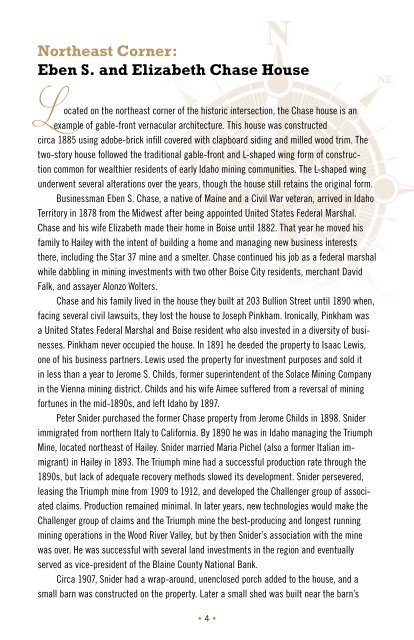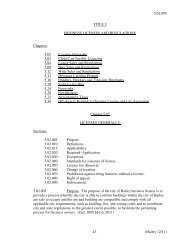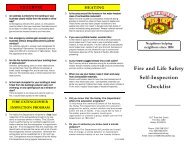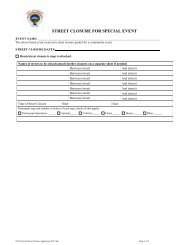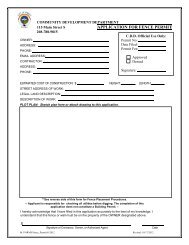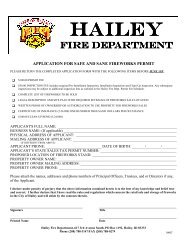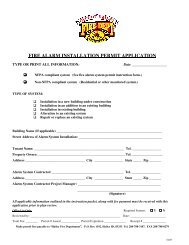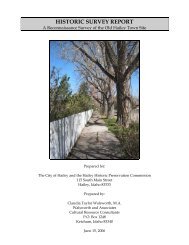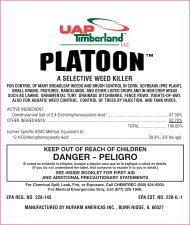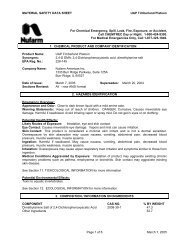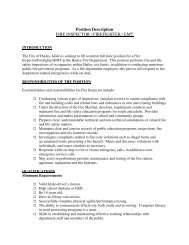Create successful ePaper yourself
Turn your PDF publications into a flip-book with our unique Google optimized e-Paper software.
Northeast Corner:<br />
Eben S. and Elizabeth Chase House<br />
L<br />
ocated on the northeast corner <strong>of</strong> the historic intersection, the Chase house is an<br />
example <strong>of</strong> gable-front vernacular architecture. This house was constructed<br />
circa 1885 using adobe-brick infill covered with clapboard siding and milled wood trim. The<br />
two-story house followed the traditional gable-front and L-shaped wing form <strong>of</strong> construction<br />
common for wealthier residents <strong>of</strong> early Idaho mining communities. The L-shaped wing<br />
underwent several alterations over the years, though the house still retains the original form.<br />
Businessman Eben S. Chase, a native <strong>of</strong> Maine and a Civil War veteran, arrived in Idaho<br />
Territory in 1878 from the Midwest after being appointed United States Federal Marshal.<br />
Chase and his wife Elizabeth made their home in Boise until 1882. That year he moved his<br />
family to <strong>Hailey</strong> with the intent <strong>of</strong> building a home and managing new business interests<br />
there, including the Star 37 mine and a smelter. Chase continued his job as a federal marshal<br />
while dabbling in mining investments with two other Boise <strong>City</strong> residents, merchant David<br />
Falk, and assayer Alonzo Wolters.<br />
Chase and his family lived in the house they built at 203 Bullion Street until 1890 when,<br />
facing several civil lawsuits, they lost the house to Joseph Pinkham. Ironically, Pinkham was<br />
a United States Federal Marshal and Boise resident who also invested in a diversity <strong>of</strong> businesses.<br />
Pinkham never occupied the house. In 1891 he deeded the property to Isaac Lewis,<br />
one <strong>of</strong> his business partners. Lewis used the property for investment purposes and sold it<br />
in less than a year to Jerome S. Childs, former superintendent <strong>of</strong> the Solace Mining Company<br />
in the Vienna mining district. Childs and his wife Aimee suffered from a reversal <strong>of</strong> mining<br />
fortunes in the mid-1890s, and left Idaho by 1897.<br />
Peter Snider purchased the former Chase property from Jerome Childs in 1898. Snider<br />
immigrated from northern Italy to California. By 1890 he was in Idaho managing the Triumph<br />
Mine, located northeast <strong>of</strong> <strong>Hailey</strong>. Snider married Maria Pichel (also a former Italian immigrant)<br />
in <strong>Hailey</strong> in 1893. The Triumph mine had a successful production rate through the<br />
1890s, but lack <strong>of</strong> adequate recovery methods slowed its development. Snider persevered,<br />
leasing the Triumph mine from 1909 to 1912, and developed the Challenger group <strong>of</strong> associated<br />
claims. Production remained minimal. In later years, new technologies would make the<br />
Challenger group <strong>of</strong> claims and the Triumph mine the best-producing and longest running<br />
mining operations in the Wood River Valley, but by then Snider’s association with the mine<br />
was over. He was successful with several land investments in the region and eventually<br />
served as vice-president <strong>of</strong> the Blaine County National Bank.<br />
Circa 1907, Snider had a wrap-around, unenclosed porch added to the house, and a<br />
small barn was constructed on the property. Later a small shed was built near the barn’s<br />
The Chase Home - January, 1906<br />
west elevation. Snider deeded the house to his wife, Maria, in 1918 and died the following<br />
year. Maria lived on the property with her daughters, Helena and Corrina. Helena continued<br />
to live there while on break from her education in Boise and Chicago. The 1930 census shows<br />
Leo Snider, Maria and Peter’s son, also briefly living there while he worked on the Snider<br />
mining claims.<br />
In 1931, Maria Snider was living in a one-room cottage (no longer extant) that had been<br />
built east <strong>of</strong> the main house. Helena Snider married Norman Vought in Washington in 1938.<br />
She and her husband worked as government employees, living in various states until their<br />
retirement. They came to Idaho <strong>of</strong>ten, staying in the main house. Helena taught music there.<br />
After Maria’s death in 1956, the Voughts sold the house. The property changed hands at least<br />
two more times until purchased by John and Martha Burke in the early 1970s. As <strong>of</strong> 2011,<br />
<strong>Hailey</strong> city councilwoman Martha (Beaver) Burke still resides in the house.<br />
The Life <strong>of</strong> a Local<br />
Photo courtesy <strong>of</strong> BCHM<br />
John M. “Jack” Rutter arrived in <strong>Hailey</strong> in 1907 from<br />
Cornwall, England. Jack worked in the mines for a year<br />
before finding work with John Povey, a local builder. In<br />
1911, Jack married his employer’s daughter Katherine and<br />
struck out on his own as a builder. By the time he created<br />
the final plans and supervised construction <strong>of</strong> the <strong>Hailey</strong><br />
Masonic Lodge, he had been a builder for almost thirty<br />
years and had built many residences and commercial<br />
buildings in <strong>Hailey</strong> and throughout southern Idaho.<br />
• 4 • • 5 •


